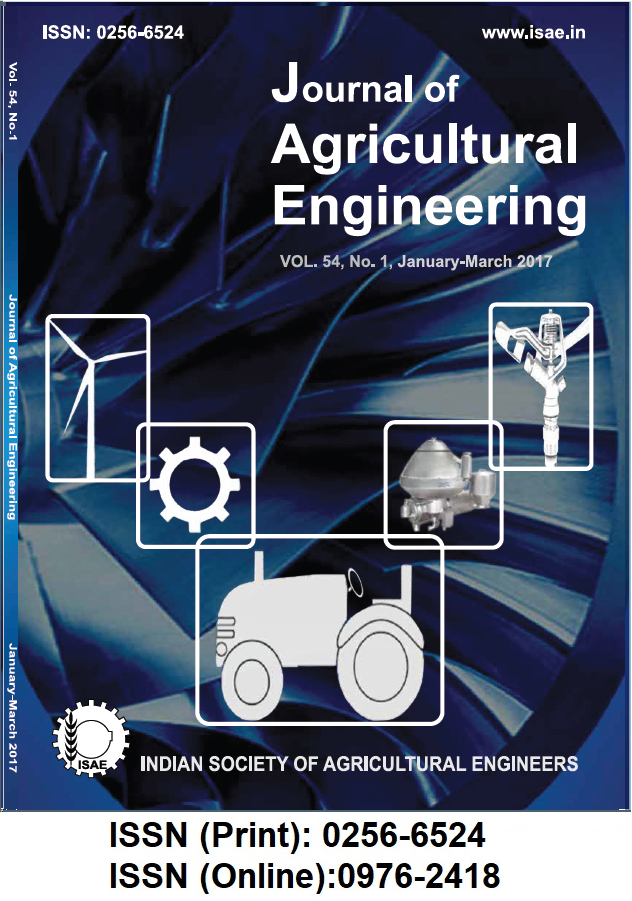Growth, Yield and Water Use Efficiency Response of Greenhouse Grown Capsicum under Deficit and PRD Method of Irrigation
DOI:
https://doi.org/10.52151/jae2017541.1617Keywords:
Partial root drying, deficit irrigation, water use efficiencyAbstract
A study was conducted to compare two water-saving practices, deficit irrigation (DI) and partial root zone drying (PRD), and to examine how they affect water use, growth and yield of greenhouse grown capsicum compared to control irrigation (CI). The effect of PRD on the growth of capsicum plant was significant. The results showed that capsicum fruit yield was highest for control (full irrigation), followed by the deficit irrigation treatment (DI-75 %) and then 1 PRD treatment. The analysis suggested that the treatment 1 PRD outperformed 2 PRD and DI-50 in terms of fruit yield. The yield loss in PRD treatment was only 11.1 % compared to control, whereas amount of water applied was 50 % less than through control irrigation. The highest water use efficiency was achieved for treatment of 1 PRD with 63 % improvement in irrigation efficiency over control. The treatment 1 PRD used 20.60 litres of water to produce 1 kg capsicum as against 33.61 litres under control treatment.
References
Dorji K; Behboudian M H; Zegbe-Dominguez J A. 2005. Water relations, growth, yield and fruit quality of hot pepper under deficit irrigation and partial rootzone drying. Sci. Hortic., 105, 138–149.
Guang-Cheng Shaho; Zhan-Yu Zhang; Na Liu; Shuang-En Yu; Xing Weng-Gang. 2008. Comparative effects of deficit irrigation and partial root zone drying on soil water distribution, water use, growth and yield in greenhouse grown hot peeper. Sci. Hortic., 119, 11-16.
Guan-cheng, Shao; Na Liu; Zhan-Yu Zhang; Shuang-En Yu; Chang-ren Cheng. 2010. Growth, yield and water use efficiency response of greenhouse-grown hot pepper under Time-Space deficit irrigation. Sci. Hortic., 126, 172-179.
Gersani M; Sachs T. 1992. Development correlations between roots in heterogeneous environment. Plant Cell Environ., 15, 463–469.
Jones H G. 1992. Plants and Microclimate: A Quantitative Approach to Environmental Plant Physiology. 2nd ed., Cambridge University Press, Cambridge, pp: 428.
Kang S; Hu X; Li Z; Jerie P. 2002. Soil water distribution, water use and yield response to partial root zone drying under shallow groundwater conditions in a pear orchard. Sci. Hortic., 92, 277–291.
Loveys B R; Stoll M; Dry P R; McCarthy M G. 2000. Using plant physiology to improve the water use efficiency of horticultural crops. Acta Hortic., 537, 187–197.
Panigrahi P; Sahu N N. 2013. Evapotranspiration and yield of okra as affected by partial root-zone furrow irrigation. Int. J. Plant Prod., 7 (1), 33-53.
Shahnazri A; Fulai Liu; Andersen M N; Jacobsen S E; Jensen E R. 2007. Effects of partial root zone drying on yield, tuber size and water use efficiency in potato under field condition. Field Crops Res., 100, 117-124.
Singh D P; Anand N; Deshpande A A. 1993. Improvement of bell pepper. In: Chadha K L; Kallo G (Eds.), Advances in Horticulture, Vegetable Crops, Malhotra Publishing House, New Delhi, Vol. 5, Part I, 87-104.
Tan C S; Cornelisse A; Buttery B R. 1981. Transpiration, stomatal conductance, and photosynthesis of tomato plants with various proportions of root system supplied with water. J. Am. Hortic. Sci., 106, 147–151.














